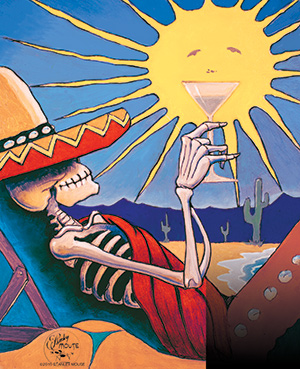It’s both fitting and weird that the Grateful Dead’s Northern California farewell shows will unfold next week at Levi’s Stadium in Santa Clara.
A natural, sure, because their roots are here. And strange because celebrating outlaw culture amongst the corporate suites of a billion-dollar Super Bowl stadium completes a transformation Don Henley took note of three decades ago when he spotted a Deadhead sticker on a Cadillac.
The quirky jug and washboard players turned psychedelic noodlers sprang from Peninsula suburbs and rebranded themselves as the Grateful Dead in San Jose, at a Victorian that was moved to make way for the City Hall dome.
Tom Wolfe called the Dead’s San Jose show “the first mass acid experience, the dawn of the Psychedelic, the Flower Generation.” Magazine publisher Jann Wenner emails that he remembers heading to 43 S. Fifth Street “after a Rolling Stones show at the San Jose Civic Auditorium, on December 4, 1965.
Answering the phone after a day of hay-baling on his Oregon farm, Merry Prankster Ken Babbs says “we made up some flyers” to hand out at the Stones show. “We took in a dollar at the door,” Babbs recalls, a bit less than what fans (just add three zeroes) are paying on the resale market for seats 50 years later.
“I’m putting lipstick on a skeleton right now,” says the longtime Dead album cover artist, Stanley Mouse, describing his latest work, “Cash Grab,” a term that’s been bandied about the Deadosphere to describe the five stadium shows in California and Chicago. “I stamped ‘GUILTY’ over my own signature.” (Mouse was nice enough to share one of his latest works for this week’s Metro cover.)
A veteran Bay Area promoter calls the haul, at least $50 million when merchandise and ancillary rights like pay-per-view are factored in, “one of the biggest grosses of all time.”
“I can’t remember ever seeing three sold-out stadium shows in one [U.S.] city,” he says. Chicago tourism officials expect the three shows to contribute an additional $50 to $100 million to the Windy City’s economy, which means that not all of their fans are bringing dogs and sleeping in their cars. That’s likely the case here as well.
Still, what’s most notable is not how much the iconic rock group will pocket—but how much they left on the table. Based on unfilled ticket requests, they could have sold at least four times the number of tickets and raised prices by more than 50 percent. The Dead would have had one of the highest-grossing tours in history with only a fraction of the number of performances it usually takes. Who would have thought that a band whose members have an average age of over 70 would be the year’s hottest act?
As we say here in Silicon Valley, it takes a long time to become an overnight success. It only took the Grateful Dead half a century to take the long, strange trip from Magoo’s Pizza Parlor to Sand Hill.
And, just as the Grateful Dead is a product of the Bay Area’s southern suburbs, it’s been argued that the personal computer revolution and modern Silicon Valley itself are products of the counterculture. From Burning Man to Steve Jobs’ experimentation with LSD, chemically-induced mind expansion contributed to the culture of creativity, nonconformity and disruption that produced the world’s most valuable company, transformed modern business culture and is now reinventing practically every organized sphere of modern existence.
Memories are fuzzy of the counterculture’s public debut at an all night party forty-nine-and-a-half years ago, and there were no smartphones to record the moment. The secret’s now entombed in the cement outside City Hall.
It will be released in the air above the 49ers’ field for two special nights, aided by an advanced sound system. The magic happens also happens daily in the valley’s most mundane corners, and you never know who was there or what happened before. Once in a while you get shown the light In the strangest of places if you look at it right. *Robert Hunter
Intro | Palo Alto | Menlo Park | Stanford | San Jose | Los Gatos | Santa Cruz




